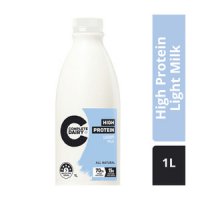i dont remember exactly where, its a few milk/pasteurization related sites apparently these are the legal requirements. it has to be 161 degrees for 15 seconds, 145 degrees for 30 minutes, or i think something like 280 degrees for 2 secondsWhere did you get those figures from?
On a diff note I’m more concerned with homogenization damaging milk than pasteurization
Navigation
Install the app
How to install the app on iOS
Follow along with the video below to see how to install our site as a web app on your home screen.
Note: This feature may not be available in some browsers.
More options
-
By using this site you agree to the terms, rules, and privacy policy.
-
Charlie's Restoration Giveaway #2 (Entire Home EMF Mitigation & Protection Along With Personal Protection) - Click Here To Enter
-
Dear Carnivore Dieters, A Muscle Meat Only Diet is Extremely Healing Because it is a Low "vitamin A" Diet. This is Why it Works so Well...
Rest the rest of this post by clicking here
-
The Forum is transitioning to a subscription-based membership model - Click Here To Read
Click Here if you want to upgrade your account
If you were able to post but cannot do so now, send an email to admin at raypeatforum dot com and include your username and we will fix that right up for you.
You are using an out of date browser. It may not display this or other websites correctly.
You should upgrade or use an alternative browser.
You should upgrade or use an alternative browser.
Other than raw milk what brand and(or) type of milk do you enjoy?
- Thread starter PeatandPotatoes
- Start date
CreakyJoints
Member
- Joined
- Mar 30, 2020
- Messages
- 304
@Mr.Bollox @LUH 3417
I hadn't thought about it all that much until I read your exchange. I looked into it only a little bit, and didn't realise the effect (or lackthereof) of refrigeration would be so pronounced, although it stood to reason that boiling would have this sort of impact. If you just read the abstract for the second one, don't panic about their comments about sugar decreasing vitamin content - they boiled the sugar group.
I hadn't thought about it all that much until I read your exchange. I looked into it only a little bit, and didn't realise the effect (or lackthereof) of refrigeration would be so pronounced, although it stood to reason that boiling would have this sort of impact. If you just read the abstract for the second one, don't panic about their comments about sugar decreasing vitamin content - they boiled the sugar group.
Last edited:
what is it please whats the refrigerations effects@Mr.Bollox @LUH 3417
I hadn't thought about it all that much until I read your exchange. I looked into it only a little bit, and didn't realise the effect of refrigeration would be so pronounced, although it stood to reason that boiling would have this sort of impact. If you just read the abstract for the second one, don't panic about their comments about sugar decreasing vitamin content - they boiled the sugar group.
apparently both heating and freezing ground meats reduced vitamin content.
CreakyJoints
Member
- Joined
- Mar 30, 2020
- Messages
- 304
what is it please whats the refrigerations effects
apparently both heating and freezing ground meats reduced vitamin content.
It's right there in the abstract of the study on raw milk I linked, you should have a look: the microbial populations increased during refrigeration, reaching after 72 h values of about 8.0 log cfu/mL for Pseudomonas spp., 6.5 log cfu/mL for yeasts, and up to 4.0 log cfu/mL for Enterobacteriaceae.
And from the full study,
- •
C0: untreated raw milk subjected to analysis immediately after its delivery to the laboratory; - •
C24: untreated raw milk subjected to analysis after 24 h of storage at 4.0 ± 0.5°C; - •
C48: untreated raw milk subjected to analysis after 48 h of storage at 4.0 ± 0.5°C; - •
C72: untreated raw milk subjected to analysis after 72 h of storage at 4.0 ± 0.5°C;
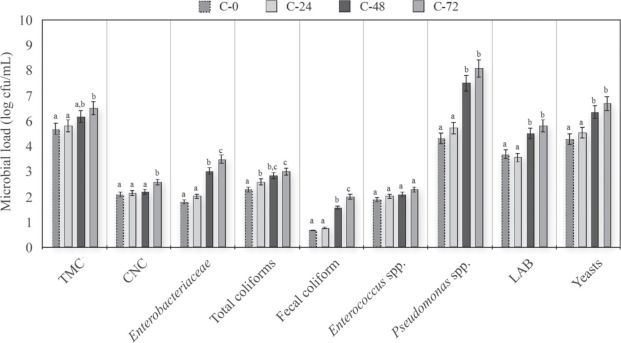
There are some other interesting bits, too. I liked the bar chart elsewhere which almost looked like they had forgotten to add half the results onto because the microbial content after boiling was so low.
I also found it interesting that there was such a marked difference between 750W and 900W treatment in a microwave, but obviously it does make sense when you think about it. See figure 4 and the paragraph immediately before it.
CreakyJoints
Member
- Joined
- Mar 30, 2020
- Messages
- 304
what is it please whats the refrigerations effects
apparently both heating and freezing ground meats reduced vitamin content.
Obviously these concentrations would probably be significantly higher without refrigeration, I'm not condoning that you leave your milk out in the open. I was really just trying to show you both some studies which dealt with the effects of heat treatment in case you were interested.
i should include this long and challenging study about microfiltration and dairy
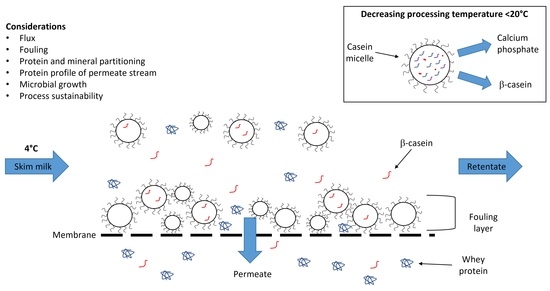
 www.mdpi.com
www.mdpi.com

Cold Microfiltration as an Enabler of Sustainable Dairy Protein Ingredient Innovation
Classically, microfiltration (0.1–0.5 µm) of bovine skim milk is performed at warm temperatures (45–55 °C), to produce micellar casein and milk-derived whey protein ingredients. Microfiltration at these temperatures is associated with high initial permeate flux and allows for the retention of...
cold pasteurized?what is your opinion on cold filtered milk? this process increases the protein and calcium significantly but reduces the lactose
the guernsey milks are naturally homogenized, supposedly very high fat yet the mouthfeel is like 2% regular milk. taste is inferior to most other kinds of milk.
taste wise the best is a low temp pasteurized, non homogenized jersey and holstein mix milk. they're grass fed 50% of the year, the rest of the year they're fed organic corn. so the PUFA may be slightly higher than 100% grass fed milks, but taste wise it's good.
jersey cow milk likely has the most vitamin K2, but the mouthfeel is extremely rich and creamy. It's harder to drink more of because of how filling it is. some of the jersey milks are a light orange color!
i havent had any camel, sheep or goat milk that tasted good. buffalo milk tastes decent.
there are some parts of the world where yak milk, reindeer milk or horse milk are commonly drank. it's hard to find these in the US, most farms aren't milking the horses. there is a made in China donkey milk powder available on amazon. I have found yak meat here, and it tastes better than most store bought beef.
taste wise the best is a low temp pasteurized, non homogenized jersey and holstein mix milk. they're grass fed 50% of the year, the rest of the year they're fed organic corn. so the PUFA may be slightly higher than 100% grass fed milks, but taste wise it's good.
jersey cow milk likely has the most vitamin K2, but the mouthfeel is extremely rich and creamy. It's harder to drink more of because of how filling it is. some of the jersey milks are a light orange color!
i havent had any camel, sheep or goat milk that tasted good. buffalo milk tastes decent.
there are some parts of the world where yak milk, reindeer milk or horse milk are commonly drank. it's hard to find these in the US, most farms aren't milking the horses. there is a made in China donkey milk powder available on amazon. I have found yak meat here, and it tastes better than most store bought beef.
the guernsey milks are naturally homogenized, supposedly very high fat yet the mouthfeel is like 2% regular milk. taste is inferior to most other kinds of milk.
Are you sure you’re not thinking of milk from Dutch Belted, Dexters or Zebus? If I’m not mistaken, Guernsey is a sub-breed of the Jersey—both originate from the Channel Islands—and just like Jersey milk, Guernsey milk isn’t naturally homogenized. I just made some ice cream with Guernsey milk an hour ago so the cream was mixed in, but you should hopefully be able to make out that there is already a cream line forming:
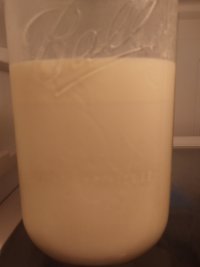
Ras
Member
- Joined
- Sep 12, 2015
- Messages
- 938
I think this milk is great.
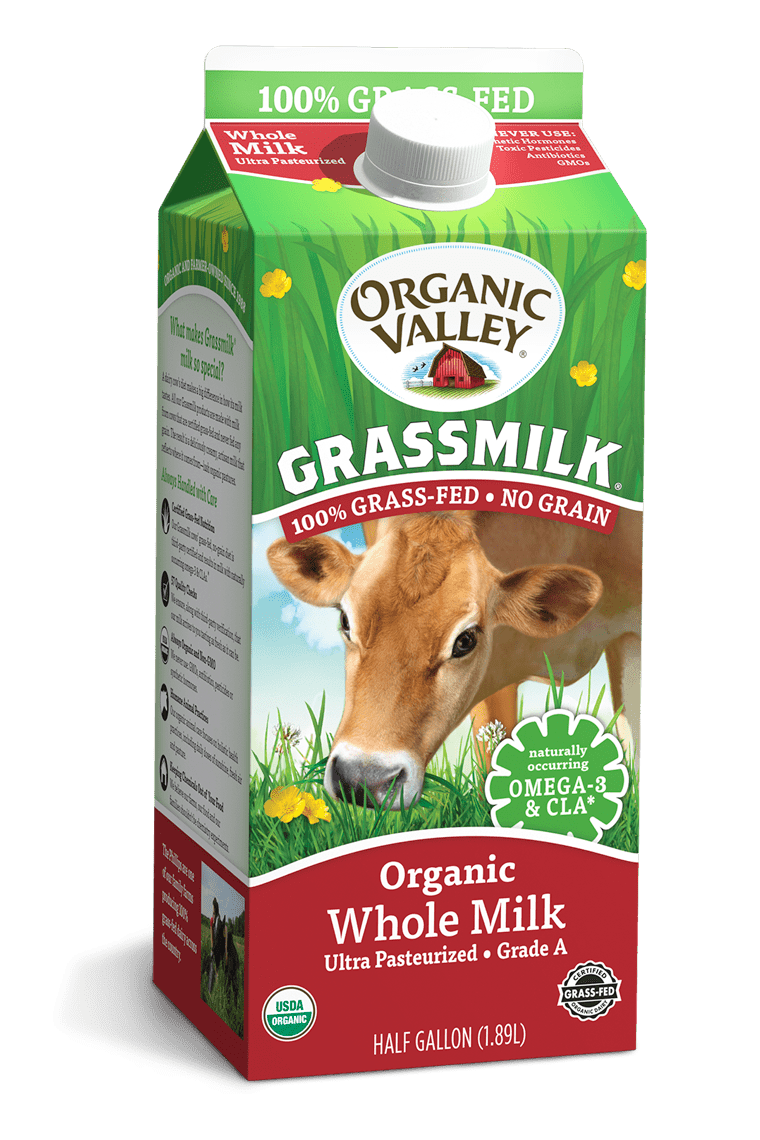
 www.organicvalley.coop
www.organicvalley.coop


Whole Grassmilk® - Half Gallon | Organic Valley
Grassmilk® milk combines the latest modern methods with time-honored secrets of organic farming. Our whole Grassmilk® comes from cows that eat organic grass and dried forages, because we think that's the diet nature intended for them. And now, <a...
Mossy
Member
- Joined
- Jun 2, 2017
- Messages
- 2,043
These days I buy the cheap store brand milk.
My greatest concern about milk now is to be able to find good information on dairies that haven't, and wont have to, vaccinate their cows.
My greatest concern about milk now is to be able to find good information on dairies that haven't, and wont have to, vaccinate their cows.
It is also one of the islands cows but yes it was guernsey, the flavor has a sweeter taste than jersey, one of the farms me ntins its naturally homogenized. Not as homogenized as homogenized milk, but theres no big cream layer like how jersey milk forms the two inch+ cream layer on the top!Are you sure you’re not thinking of milk from Dutch Belted, Dexters or Zebus? If I’m not mistaken, Guernsey is a sub-breed of the Jersey—both originate from the Channel Islands—and just like Jersey milk, Guernsey milk isn’t naturally homogenized. I just made some ice cream with Guernsey milk an hour ago so the cream was mixed in, but you should hopefully be able to make out that there is already a cream line forming:
View attachment 43763
It is also one of the islands cows but yes it was guernsey, the flavor has a sweeter taste than jersey, one of the farms me ntins its naturally homogenized. Not as homogenized as homogenized milk, but theres no big cream layer like how jersey milk forms the two inch+ cream layer on the top!
I think this is a perfect example of how much milk is influenced by farming practices, diet of the herd, climate and time of year—the cows here produce fattier milk during a certain time of year—because the Guernsey milk I get is not like the Guernsey milk you described having. I just picked up my milk order this evening and you can see how it has already formed a 2 1/2” layer of cream:
Is that 100% guernsey or mixed? The jar mentions jersey and guernseyI think this is a perfect example of how much milk is influenced by farming practices, diet of the herd, climate and time of year—the cows here produce fattier milk during a certain time of year—because the Guernsey milk I get is not like the Guernsey milk you described having. I just picked up my milk order this evening and you can see how it has already formed a 2 1/2” layer of cream:
View attachment 43827
Theres been a few farms selling guernsey only and theve mentioned the natural homogenization, and lack of cream layer!
If 100% grass fed, jersey turns into a light orange color!
Guernsey stays white or cream white!
@Dr. B, it’s 100% Guernsey. If you look right under the logo on the label, you’ll see where it says milk from certified A2 Guernseys. I spoke with the owners prior to buying it, since their Jersey herd isn’t A2 certified, and they confirmed the milk is from their Guernsey herd. I think they use the Jersey milk for their yogurt, but I buy the milk at the market so perhaps they also sell Jersey milk at the farm. I also get 100% Jersey milk from a farm 10 minutes from my house and the milk contains a comparable amount of cream.
Guernsey stays white or cream white!
I forgot to address this. Guernsey milk is known for its golden color:
“Guernsey milk has several unique properties.
1 – Beta Carotene – As this is not digested and broken down by Guernsey cows it passes into the milk and creates the wonderful golden colour.
2 – Omega 3 – Guernsey milk contains three times as much Omega 3 as other milks.
3 – Beta Casein A2 – All of the samples of Guernsey milk tested in the UK has more than 80% A2 which compares with 40% A2 in Jersey milk and 15% in ‘ordinary milk’.”
1 – Beta Carotene – As this is not digested and broken down by Guernsey cows it passes into the milk and creates the wonderful golden colour.
2 – Omega 3 – Guernsey milk contains three times as much Omega 3 as other milks.
3 – Beta Casein A2 – All of the samples of Guernsey milk tested in the UK has more than 80% A2 which compares with 40% A2 in Jersey milk and 15% in ‘ordinary milk’.”
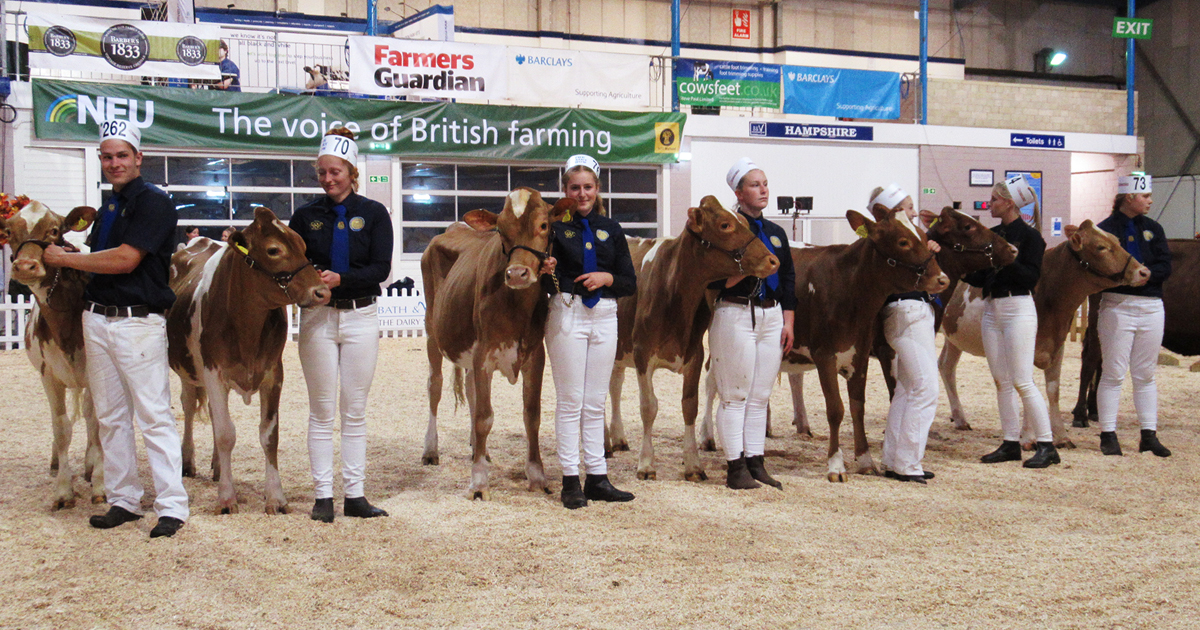
Unique Properties of Guernsey Milk and Milk Products - English Guernsey Cattle Society
Guernsey milk has several unique properties. 1 – Beta Carotene – As this is not digested and broken down by Guernsey cows it passes into the milk and creates the wonderful golden colour. 2 – Omega 3 – Guernsey milk contains three times as much Omega 3 as other milks. 3 – Beta Casein A2Continue...
 guernseycattle.com
guernseycattle.com
It is goldish, but somehow doesnt seem to get orange like the jersey milks! The pictures you posted do look like guernsey milks ive seenI forgot to address this. Guernsey milk is known for its golden color:
“Guernsey milk has several unique properties.
1 – Beta Carotene – As this is not digested and broken down by Guernsey cows it passes into the milk and creates the wonderful golden colour.
2 – Omega 3 – Guernsey milk contains three times as much Omega 3 as other milks.
3 – Beta Casein A2 – All of the samples of Guernsey milk tested in the UK has more than 80% A2 which compares with 40% A2 in Jersey milk and 15% in ‘ordinary milk’.”

Unique Properties of Guernsey Milk and Milk Products - English Guernsey Cattle Society
Guernsey milk has several unique properties. 1 – Beta Carotene – As this is not digested and broken down by Guernsey cows it passes into the milk and creates the wonderful golden colour. 2 – Omega 3 – Guernsey milk contains three times as much Omega 3 as other milks. 3 – Beta Casein A2Continue...guernseycattle.com
This is what one farm posted about guernsey and goats milk
prefer the smoother, silkier, more naturally homogenized appearance and taste of our Golden Guernsey milk—this is similar to the reason raw goat milk appears naturally homogenized due to smaller fat globules.
It is goldish, but somehow doesnt seem to get orange like the jersey milks! The pictures you posted do look like guernsey milks ive seen
This is what one farm posted about guernsey and goats milk
prefer the smoother, silkier, more naturally homogenized appearance and taste of our Golden Guernsey milk—this is similar to the reason raw goat milk appears naturally homogenized due to smaller fat globules.
I don’t know if it’s because of the fridge light, but it’s darker on the counter in natural daylight. The Jersey milk I get isn’t any darker than the Guernsey milk and unlike the latter, the former is 100% grass-fed. I don’t currently have any jars of the Jersey milk to compare the two side by side for you, but here’s a picture of the milk from the farm’s website:


BENEDIKT DAIRY
I’m not really sure what else to say in regards to why that one farm’s milk would be white and more homogenized in appearance. I mean, just doing a quick search I get these descriptions for color and cream separation:
“Her qualities as the producer of an unique golden coloured milk high in Protein and Butterfat and rich in flavour made her the envy of the emerging dairy industry of the nineteenth and early twentieth centuries.”
The Excellent Modern Dairy Breed — The World Guernsey Cattle Federation
“The Golden Guernsey legacy continues today with its rich, creamy, golden milk and beautiful brown cows. Become an American Guernsey Association member today to be a part of the Guernsey legacy.”

Golden Guernsey I United States I Americn Guernsey Association
The best milk option- Golden Guernsey Milk! Learn why Guernsey milk is the best and where you can buy it today.
“Guernseys’ Golden Product
The Guernsey cow is known for producing high-butterfat, high-protein milk with a high concentration of beta carotene. Being of intermediate size, Guernseys produce their high-quality milk while consuming 20-30 percent less feed per pound of milk produced than larger dairy breeds. Other attractive characteristics of Guernseys are their lack of any known undesirable genetic recessives and their adaptability to warmer climates.”
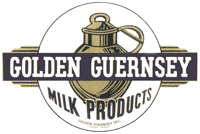
Golden Guernsey | americanguernsey
“Something unique about Guernsey milk is that it is golden in color. The golden Guernsey milk is because of the abundance of beta carotene. There is beta carotene in their feed and Guernsey’s don’t break down beta carotene like other dairy breeds, so it goes straight into their milk for the consumer. Beta carotene is an antioxidant and has many health benefits.”
The Guernsey Breed | NGFF
“GOLDEN GUERNSEY AND RICH MILK
A distinctive characteristic of the breed is the golden color of its milk, which results from exceptionally high levels of carotene, a precursor to Vitamin A. It is thought that the Guernsey excels in its ability to absorb this nutrient and transfer it to butterfat. Guernsey milk has been promoted under the trademark “Golden Guernsey.”
Buy Golden Guernsey Goodness from Pleasant Meadow Creamery
Golden Guernsey Goodness is the historical way Guernsey cow milk has been marketed since the early 1900s. Guernsey milk is the best.
pleasantmeadowcreamery.com
Our milk is a true commodity on the shelf, it comes from a cow breed which produces something we see as close to liquid gold as you can get. This breed produces milk that even some people with lactose intolerance can drink. Grace Harbor Farms milk does not cause as much inflammation as other milk.
Our milk comes from guernsey cows, we don’t seperate the milk, so you’ll be getting full fat cream top, just the way farms have been doing it for centuries.”
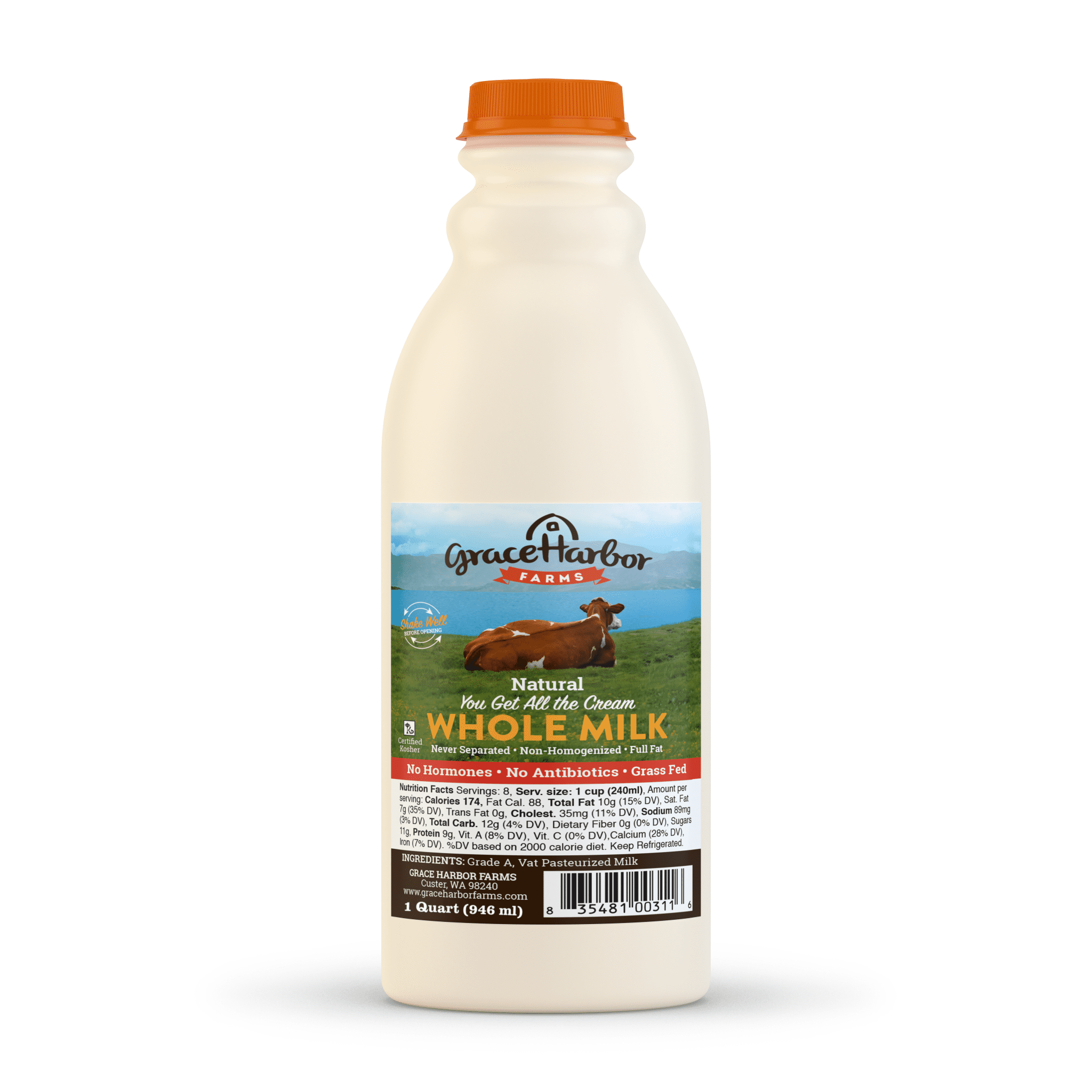
Milk ⋆ Grace Harbor Farms
Our milk is different than 90% of milk on the shelves, and there are 3 reasons: Unique milk Our milk is a true commodity on the shelf, it comes from a cow breed which produces something we see as close to liquid gold as you can get. This breed produces milk that even some people... Read more →
“Creamline milk is the most natural form of milk. It is pasteurized, just like most milk found on store shelves, but the biggest difference is that the milk is not homogenized or separated as we provide it to you the way it comes out of our Guernsey cows on pasture all the time. Creamline can aid the body in better digestion, and properly utilize the proteins found in milk. There is only one con with creamline milk, which is the need to give it a slight shake before enjoying a healthier, tastier product!”
Creamline Milk — Rock Hill Orchard & Woodbourne Creamery
“You’ve heard that “the cream always rises to the top.” Eby Manor’s Golden Guernsey whole milk holds true to this. Their non-homogenized 4.8% cream top whole milk is a milk-lovers dream and a healthy source of dairy fat. Rich and full of pure dairy goodness, you can actually see where the milk ends and the cream begins.”

Eby Manor Golden Guernsey, 4.8% Non-Homogenized Milk - Glass Bottle (1
You’ve heard that “the cream always rises to the top.” Eby Manor’s Golden Guernsey whole milk holds true to this. Their non-homogenized 4.8% cream top whole milk is a milk-lovers dream and a healthy source of dairy fat. Rich and full of pure dairy goodness, you can actually see where the milk...
“After milking we pour the raw milk through a disposable paper filter directly into our MilkPlan chiller tank, which cools the milk from 101 degrees Fahrenheit to approximately 36 degrees F in about 30-45 minutes. The bulk tank also has an automatic stirrer which agitates the milk every 15 minutes to keep the cream from separating and settling at the top.”

Barrington Natural Farms LLC - Raw Guernsey Milk
the darker color should definitely correlate with how much % grassfed the milk is, based on how they mention its the carotene from the grass being undigested, passing into the milk. the guernsey milks ive seen look the same as the one you posted, but i havent seen any with creamlines even when non homogenized. ive tried one raw milk guernsey and one store bought pasteurized but non homogenized. the 100% grass fed jersey milks ive gotten both in store and raw milks were noticeably darker than guernsey! ive bought two guernsey milks, one raw one pasteurized. jersey ive got one pasteurized, and many raw ones. since its carotene related, it could mean it's down to the type of grass and how much carotene is in the grass itself. i think grass fed can include being fed hay right? it could be that the more orange colored milks are getting more fresh grass while the less orange milks are getting more hay. or its that some grasses have more carotene than others which then changes the milk color.I don’t know if it’s because of the fridge light, but it’s darker on the counter in natural daylight. The Jersey milk I get isn’t any darker than the Guernsey milk and unlike the latter, the former is 100% grass-fed. I don’t currently have any jars of the Jersey milk to compare the two side by side for you, but here’s a picture of the milk from the farm’s website:
View attachment 43902

BENEDIKT DAIRY
www.benediktdairy.com
I’m not really sure what else to say in regards to why that one farm’s milk would be white and more homogenized in appearance. I mean, just doing a quick search I get these descriptions for color and cream separation:
“Her qualities as the producer of an unique golden coloured milk high in Protein and Butterfat and rich in flavour made her the envy of the emerging dairy industry of the nineteenth and early twentieth centuries.”
The Excellent Modern Dairy Breed — The World Guernsey Cattle Federation
www.worldguernseys.com
“The Golden Guernsey legacy continues today with its rich, creamy, golden milk and beautiful brown cows. Become an American Guernsey Association member today to be a part of the Guernsey legacy.”

Golden Guernsey I United States I Americn Guernsey Association
The best milk option- Golden Guernsey Milk! Learn why Guernsey milk is the best and where you can buy it today.www.goldenguernseydairy.com
“Guernseys’ Golden Product
The Guernsey cow is known for producing high-butterfat, high-protein milk with a high concentration of beta carotene. Being of intermediate size, Guernseys produce their high-quality milk while consuming 20-30 percent less feed per pound of milk produced than larger dairy breeds. Other attractive characteristics of Guernseys are their lack of any known undesirable genetic recessives and their adaptability to warmer climates.”

Golden Guernsey | americanguernsey
www.usguernsey.com
“Something unique about Guernsey milk is that it is golden in color. The golden Guernsey milk is because of the abundance of beta carotene. There is beta carotene in their feed and Guernsey’s don’t break down beta carotene like other dairy breeds, so it goes straight into their milk for the consumer. Beta carotene is an antioxidant and has many health benefits.”
The Guernsey Breed | NGFF
“GOLDEN GUERNSEY AND RICH MILK
A distinctive characteristic of the breed is the golden color of its milk, which results from exceptionally high levels of carotene, a precursor to Vitamin A. It is thought that the Guernsey excels in its ability to absorb this nutrient and transfer it to butterfat. Guernsey milk has been promoted under the trademark “Golden Guernsey.”
Buy Golden Guernsey Goodness from Pleasant Meadow Creamery
Golden Guernsey Goodness is the historical way Guernsey cow milk has been marketed since the early 1900s. Guernsey milk is the best.pleasantmeadowcreamery.com
Our milk is a true commodity on the shelf, it comes from a cow breed which produces something we see as close to liquid gold as you can get. This breed produces milk that even some people with lactose intolerance can drink. Grace Harbor Farms milk does not cause as much inflammation as other milk.
Our milk comes from guernsey cows, we don’t seperate the milk, so you’ll be getting full fat cream top, just the way farms have been doing it for centuries.”

Milk ⋆ Grace Harbor Farms
Our milk is different than 90% of milk on the shelves, and there are 3 reasons: Unique milk Our milk is a true commodity on the shelf, it comes from a cow breed which produces something we see as close to liquid gold as you can get. This breed produces milk that even some people... Read more →graceharborfarms.com
“Creamline milk is the most natural form of milk. It is pasteurized, just like most milk found on store shelves, but the biggest difference is that the milk is not homogenized or separated as we provide it to you the way it comes out of our Guernsey cows on pasture all the time. Creamline can aid the body in better digestion, and properly utilize the proteins found in milk. There is only one con with creamline milk, which is the need to give it a slight shake before enjoying a healthier, tastier product!”
Creamline Milk — Rock Hill Orchard & Woodbourne Creamery
www.rockhillorchard.com
“You’ve heard that “the cream always rises to the top.” Eby Manor’s Golden Guernsey whole milk holds true to this. Their non-homogenized 4.8% cream top whole milk is a milk-lovers dream and a healthy source of dairy fat. Rich and full of pure dairy goodness, you can actually see where the milk ends and the cream begins.”

Eby Manor Golden Guernsey, 4.8% Non-Homogenized Milk - Glass Bottle (1
You’ve heard that “the cream always rises to the top.” Eby Manor’s Golden Guernsey whole milk holds true to this. Their non-homogenized 4.8% cream top whole milk is a milk-lovers dream and a healthy source of dairy fat. Rich and full of pure dairy goodness, you can actually see where the milk...canaryandfox.com
“After milking we pour the raw milk through a disposable paper filter directly into our MilkPlan chiller tank, which cools the milk from 101 degrees Fahrenheit to approximately 36 degrees F in about 30-45 minutes. The bulk tank also has an automatic stirrer which agitates the milk every 15 minutes to keep the cream from separating and settling at the top.”

Barrington Natural Farms LLC - Raw Guernsey Milk
barrington-natural-farms.com
this is the store bought guernsey milk, it doesnt have a noticeable creamline but sometimes has chunks of cream when drinking it.
but also something notable, on kalona supernaturals website they have an article about vitamin K2 and they state that the deeper yellow color the milk is the more vitamin K2 it has. because of that I have been going for the darkest milks I can find and its been jersey with both the store brands and raw milk farms available.
EMF Mitigation - Flush Niacin - Big 5 Minerals
Similar threads
- Replies
- 67
- Views
- 16K
- Replies
- 11
- Views
- 1K
K

